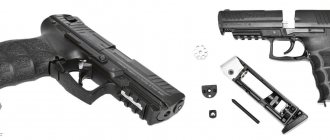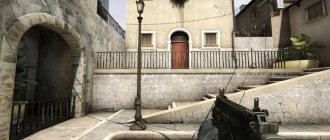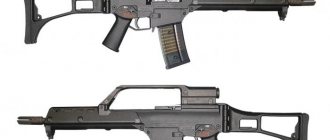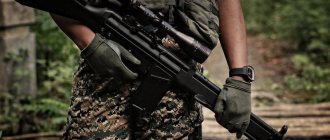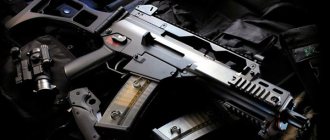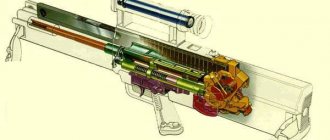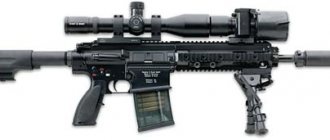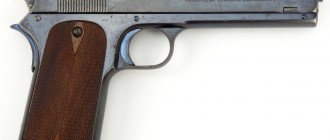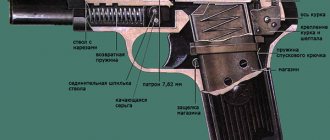is still a fairly young weapons manufacturer, but almost every one of its developments became widely known and spread throughout the world. The G3 automatic rifle was produced in Mexico and Iran. The MP5 submachine gun surpassed its competitors so much that it became a kind of “standard” for such weapons. But H&K pistols, despite their high quality and unusual design, could not achieve world fame for some time.
The situation changed in the 1990s. Universelle Selbstladepistole, a USP, entered the scene and proved that Heckler & Koch could achieve leadership in this area as well.
History of creation
founded after the Second World War by former engineers. Using the equipment that they managed to salvage from the destroyed workshops, they opened their own workshop.
Heckler & Koch began developing and producing weapons in the 50s, and the first pistol, designated P4, appeared in 1967. It was a small pocket pistol, similar in design to the pre-war Mauser HSc. Its interesting feature was the ability to easily change the caliber (to one of four) by replacing the barrel and magazine.
In the seventies, H&K released the original VP70 pistol with a polymer frame and the ability to fire automatically.
It was followed by the H&KP7, designed specifically for police and adopted in a dozen countries. But the real popularity of Heckler & Koch personal weapons came from the USP that appeared in the nineties.
It is not surprising that the “universal self-loading” weapon should become such a famous weapon. Unlike its ancestors, H&K created it specifically for the American market.
This weapon, first of all, had to satisfy the desires of the huge mass of US civilian shooters. For the same reason, options were immediately developed not only for the standard 9x19 mm cartridge for Europe, but also for the traditional .45 ACP cartridge for America, and the new (and promising at that time) .40 S&W.
In the late 80s, a version of the pistol took part in a competition to create a new weapon for American special operations forces. This project eventually gave rise to the famous Mk 23 for special forces, but the experience gained was also useful in fine-tuning the USP. It went into production in .40 caliber in 1993, followed by a nine-millimeter version. Finally, in 1995, the USP 45 model went on sale.
Heckler&Koch USP
Anyone interested in the weapons and equipment of “special operations forces” has noticed how “special forces” value personal weapons. Regardless of the presence of individual (submachine gun, rifle, machine gun, carbine) or group (light machine gun, grenade launcher) weapons, almost every fighter carries a pistol as an auxiliary weapon. Apparently not satisfied with the “defensive” nature of modern pistols, the US Special Operations Command (US SOCOM) announced a program to create an “offensive handgun” in the late 80s. It must be said that the idea of turning a pistol into the main “weapon of the last throw” is not new. Even during the First World War, the Germans armed assault teams with powerful long-barreled pistols such as the Parabellum Artillery or Parabellum Carbine. The famous military theorist A. Neznamov wrote in his book “Infantry” (1923): “In the future... for a “strike”, it may be more profitable to replace a weapon with a bayonet with a pistol with a dagger (a pistol with 20 rounds in the magazine and a range of up to 200 m) " However, in the military and even in the police field, this task was solved at that time by submachine guns. In the 1980s, the idea of a powerful “assault” pistol was revived again, but this time it was associated with the needs of special forces. Bulky models like GA-9, R-95, etc. hit the market. Their appearance, accompanied by noisy advertising, was not accidental.
According to a number of American experts, the 9-mm M9 pistol (Beretta 92, SB-F), which was put into service in 1985 to replace the 11.43-mm M1911A1 Colt, does not fully meet the requirements of close combat in terms of accuracy and effective firing range. With a silencer, the effectiveness of the pistol is noticeably reduced. SOCOM wanted to get a compact melee weapon (up to 25-30 m) that could be carried in a holster. He was supported by the US Army Command. Since combat swimmer teams (SEALS) were to be among the “consumers” of weapons, the basic requirements of the program were presented in October 1990 by the Navy Special Warfare Center. It was planned to receive the first 30 prototypes by March 1992, to test full-scale samples in January 1993, and in December 1993 to receive a batch of 9,000 pieces. In military periodicals, the new project was immediately dubbed “Supergun”.
The main applications considered were: combat on the street and inside buildings, covert entry into a facility with the removal of sentries, the release of hostages, or vice versa - kidnappings of military or political figures.
The “supergun” was considered as a complex that included not only a “family” of cartridges and a self-loading pistol, but also a silent and flameless shooting device, plus an “aiming unit.” The modular design allowed for the assembly of two main options: “assault” (pistol + aiming unit) and “stalking” with the addition of a silencer. The weight of the latter was limited to 2.5 kg, length - 400 mm.
The basic requirements for the pistol were as follows: large caliber, magazine capacity of at least 10 rounds, reloading speed, length no more than 250 mm, height no more than 150, width -35 mm, weight without cartridges - up to 1.3 kg, ease of shooting with one or two hands, high reliability in any conditions. A series of 10 bullets should fit into a circle with a diameter of 2.5 inches (63.5 mm) at 25 m. Accuracy had to be ensured by the balance of the weapon, the muzzle device - a compensator and ease of holding. The latter, in the opinion of many, implied a large slope and an almost sporty design of the handle, a bend in the trigger guard to accommodate the finger of the second hand. Two-way controls (safety, slide stop lever, magazine release) accessible to the hand holding the weapon were considered necessary. The trigger mechanism had to allow adjustment of the trigger force: 3.6-6.4 kg with self-cocking and 1.3-2.27 kg with a pre-cocked trigger. Setting the safety both when the hammer is released and when it is cocked. A safety release lever was desirable in case the shot was not needed. Sights would include a replaceable front sight and a rear sight adjustable for height and lateral displacement. For shooting at dusk, the front and rear sights would have luminous dots - a device that has become common in personal weapons.
For the “super gun” they chose the good old 11.43 mm cartridge “.45 ACP”. The reason is the requirement to specifically hit a living target in a minimum time at a maximum distance. The stopping effect of the 9×19 NATO cartridge bullet caused a number of discontent among the military. With a conventional shell bullet, a large caliber, of course, provides more guarantees of defeat with one hit. Even with body armor, the target will be disabled by the dynamic impact of an 11.43 mm bullet. The strong and sharp recoil of such cartridges was not considered significant for physically strong guys from the “special forces”. Three main types of cartridges were called:
- with a jacketed bullet of an “improved” type - in terms of improving ballistics and increasing penetration, with a bullet of increased lethality - for anti-terrorist operations, a training bullet with an easily destroyed bullet and power sufficient only for automatic operation. In addition, it was considered possible to create a bullet with increased penetration, guaranteed to hit a target protected according to the 3rd (in NATO classification) class at 25 m.
The sighting unit was conceived as a combination of two illuminators - conventional and laser. The usual one, creating a stream of light with a narrow but bright beam, was used to search and identify a target at night or in an enclosed space. The laser operated in two ranges - visible and IR (for working with night goggles like AN/PVS-7 A/B) - and could be used for quick aiming both at night and during the day. Its “spot” should have been clearly projected within the silhouette of a person at a distance of 25 m. The block could be turned on with the index finger of the hand holding the weapon.
The PBS was required to quickly (up to 15 s) attach and remove, and maintain balance. In any case, the installation of the PBS should not displace the STP by more than 50 mm at 25 m. If the pistol has an automatic weapon with a movable barrel, the muffler should not interfere with its operation.
In general, the requirements for “offensive personal weapons” did not imply anything fundamentally new and were based on already achieved parameters. This made it possible to count on the implementation of the program within three years.
At the beginning of 1993, SOCOM actually presented thirty “demonstration” samples. At the same time, the clear leaders were the two largest weapons manufacturers and Heckler und Koch. Over the course of a year, their samples were carefully studied, trying to determine ways for further development.
The Colt Industries sample was generally designed in the style of the M1911 A1 Colt pistols of the Mk-IV series - 80 and 90 with modernized retention elements and a number of improvements in the trigger mechanism and automatic operation. The controls are concentrated at the handle. For use by combat swimmers (on land, of course), all elements of the mechanism are made “waterproof.” The muffler and sighting unit also looked quite traditional.
The Heckler und Koch pistol was based on a new USP model (universal self-loading pistol). The USP was originally designed in nine and ten millimeter versions, but was chambered for the .45 ACP cartridge for the Offensive Handgun program.
USP in the version of “offensive personal weapon” with a silencer from Reda Naytos was presented in October 1993 at an exhibition organized by the Association of the American Army (AUSA). You can note the total weight of the system has been compressed to 2.2 kg, the laconic and convenient design, and the sighting unit literally integrated into the contours of the frame. Its switch is located within the trigger guard. Note that the “demonstration” samples of “Colt” and “Heckler und Koch” had a constant sight, more typical of pistols. The angle of inclination of the handle for both was less than expected. Another significant feature of the samples is the ability to release them to the market for other purposes if the Offensive Handgun program fails.
The selection of the SOCOM sample was expected in 1995. But even then the Offensive Handgun program was causing criticism. A June 1994 editorial in Modern Gun magazine simply called the idea of a large-caliber "offensive" pistol "dumb." Said with passion, but the idea is really controversial.
In fact, is it really necessary to hold on to the .45 caliber and endure the knocking effect of the recoil (the recoil force of the “.45 ACP” is 0.54 kg) and the increase in the weight of the pistol to the level of a submachine gun? The biggest stopping effect is worth nothing if the bullet misses. Maybe it’s better to put two or three bullets into the target with slightly less lethality, but better accuracy? With a total weapon length of 250 mm, the barrel length should not exceed 152 mm or 13.1 caliber, which threatens to reduce the ballistic data. Reducing the caliber would make it possible to increase the relative length of the barrel and improve accuracy. A small submachine gun with a variable firing mode remains a serious competitor to self-loading “offensive personal weapons.” This type of weapon is more versatile and, moreover, has already occupied its niche among close combat weapons.
However, in the fall of 1995, SOCOM still chose the 11.43 mm USP to implement the “third phase of the contract.” The third phase involves the production of Heckler und Koch 1950 pistols and 10,140 magazines for them with the start of deliveries by May 1, 1996. The pistol has already received the official designation Mk 23 “Mod O US SOCOM Pistol”. In total, about 7,500 pistols, 52,500 magazines and 1,950 silencers can be ordered.
Let's take a closer look at the USP device. The pistol barrel is made by cold forging on a mandrel. In combination with polygonal cutting, this gives it high accuracy and survivability. Chamber cutting allows you to use the same type of cartridges from different manufacturers and with different types of bullets. The installation of a muffler allows for an extended barrel.
Experts expected that Heckler und Koch would use a fixed-barrel design similar to its P-7. However, the USP automatic operates according to the recoil pattern of the barrel with a short stroke and locking with a skewed barrel. Unlike classic schemes, for example, “Browning High Power”, here the barrel is lowered not by a rigid pin of the frame, but by a hook installed with a buffer spring at the rear end of the return spring rod, placed under the barrel. The presence of a buffer is designed to make the automation work smoother.
The frame of the pistol is made of molded plastic, similar to the Glock and Sigma pistols. The four slide-casing guides are reinforced with steel strips to reduce wear. The magazine latch, trigger, trigger mechanism flag, cover and magazine feeder are also made of reinforced plastic. On the pistol frame itself there are guides for attaching a flashlight or laser pointer. The shutter-casing is manufactured as a single piece, milled from chrome-molybdenum steel. Its surfaces are subjected to nitro gas treatment and blued. Added to all this is a special “NOT” (“aggressive environment”) treatment, which allows the pistol to withstand immersion in sea water.
The main USP feature is its firing mechanism. At first glance, this is an ordinary hammer-type mechanism with a semi-hidden trigger and a flag placed on the frame in two positions. However, by replacing a special retaining plate, it is possible to switch it to five different operating options. The first is a double-action mechanism: when the flag is in the upper position, it is possible to fire with pre-cocking, while in the lower position it is possible to fire only by self-cocking, and lowering the flag safely releases the trigger. The second option: when the flag is moved to the top position - “safety”, to the bottom - “double action”, this is exactly the most typical for service weapons. In the third option, it is possible to fire only with preliminary cocking of the hammer, there is no safety, and the flag is used as a lever for safely releasing the hammer. The fourth option is somewhat similar to the third, but shooting is possible only by self-cocking. The fifth and final option specifies the “self-cocking” and “fuse” modes. I would like to add that in each mode the checkbox is located at your discretion - on the right or left. The first and second options best meet the requirements of the American program. Selection can only be made by a qualified technician. The trigger pull with pre-cocking is 2.5 kg, with self-cocking - 5 kg, that is, typical for a service pistol. There is also an automatic safety lock that locks the firing pin until the trigger is fully pressed. There is no magazine safety, so it is possible that a shot will be fired after it is removed; the drawback is small but still unpleasant.
The double-sided magazine release lever is located behind the trigger guard and is protected from accidental pressure. The magazine holds 12 rounds, staggered. In the upper part, the two-row magazine smoothly transitions into a single-row one, which gives it a convenient shape for equipment and improves the operation of the feeding mechanism. A step and recess at the bottom of the handle make magazine changes easy. At the end of shooting, the pistol places the bolt carrier on the bolt stop. Its extended lever is located on the left side of the frame.
The handle and frame are the same. The front side of the handle is covered with checkerboard, and the back side is covered with longitudinal corrugation, the side surfaces are rough. In combination with a thoughtful balance and an angle of inclination of the handle to the axis of the bore of 107 degrees, which makes holding the pistol very comfortable. The trigger guard of the pistol is quite large, which makes it possible to shoot while wearing thick gloves. However, due to this, the front bend on the brace is practically not used - for a rare shooter, when shooting with two hands, the index finger of the second hand will stretch out that far.
The 11.43mm USP weighs around 850g and is 200mm long. Accuracy of fire allows you to place five bullets at a distance of 45 m in a circle with a diameter of up to 80 mm. The execution and finishing of each detail corresponds to the degree of its importance. According to Heckler und Koch, the survivability of the barrel is 40,000 rounds. A replaceable rear sight with a rectangular slot and a front sight with a rectangular cross-section are installed on the bolt frame with a dovetail mount. The sights are marked with white plastic inserts or tritium dots.
Heckler und Koch also produces a “universal tactical illuminator” UTL for USP. It operates in the visible light range, has an adjustable beam angle and two switches. The first is a lever protruding inside the trigger guard so that it can be operated with the index finger. The second one, in the form of a pad, is attached with Velcro to the handle and turns on when the palm of your hand tightly grips it. UTL is powered by two 3-volt batteries.
There is also a new version of a removable muffler. It is still based on an expansion scheme. Expanded and cooled gases are discharged through openings. However, it is now clear that this weapon will undergo more than one modification and will serve the American army for many years.
Gun device
Previous USP Heckler & Koch pistols were distinguished by the use of various unconventional design solutions. For example, the P9 used a semi-blowback action, a system similar to that used in the design of the G3 rifle. But the “Heckler&Koch” USP is basically a fairly traditional design, almost like the Browning M1911 and Hi-Power. Automation uses the recoil of the barrel during its short stroke. The trigger mechanism is double action. And here we cannot do without innovations.
A remarkable feature of the USM is the variety of its operating modes.
In a workshop, you can change the position of the safety (or remove it altogether), add or eliminate a safe trigger release, or make the mechanism self-cocking only. The recoil spring buffer mechanism is built into the recoil spring assembly. According to the developers, it reduces perceived recoil by 30%.
At the bottom of the frame there is a device for mounting flashlights or laser designators. However, this is not a universal Picatinny rail mount, and therefore the USP cannot be equipped with all additional equipment. Thus, only InsightIndustries flashlights distributed through the Heckler & Koch dealer network are allowed. To get around this inconvenience, some companies have launched the production of adapters that allow you to install a standard Picatinny rail.
Design
Traditionally, Heckler & Koch used a semi-blowback with roller locking in automatic weapons - from submachine guns to light machine guns. However, the G36 turned out to be structurally similar not to its ancestors, but to the AR-18 - a rarely used and not very successful (but had a significant influence on the development of other models) rifle from Armalite. What the German rifle has in common with it is the use of gas-operated automatics with a short-stroke piston, and a bolt that locks the barrel by turning it.
The trigger mechanism, installed in a plastic receiver on pins, is made as a single module with a pistol grip.
Despite the fascination with the bullpup layout in those years, German designers built the G36 according to the classical design, using many original solutions. The barrel with polygonal rifling is made floating - not touching the fore-end along its entire length. The cocking handle has a spring-loaded segment that bends in both directions for convenience. Transparent plastic magazines received fastenings, with the help of which the magazines can be connected to each other to speed up reloading.
Standardly, the standard G36 is equipped with two sights at once - a collimator and an optical 3x magnification. 3x sight reticle – with several marks for shooting at different ranges and a rangefinder scale. An NSA 80 night sight can be installed. An auxiliary open sight is located in the carrying handle.
For use in conjunction with the G36, a 40mm AG36 underbarrel grenade launcher was developed. The weapon can be equipped with a bayonet-knife, and a bayonet from Kalashnikov assault rifles, which were in service with the NNA of the GDR, is used. All rifle variants have a lightweight folding stock.
Options
A wide variety of USP models are available - from compact ones for concealed carry to long-barreled target ones:
- CustomSport is a target modification for sports and practical shooting.
- Compact is a variant with a smaller frame and a different recoil mitigation system. Only this pistol is available in .357 SIG caliber.
- USP Tactical is a pistol equipped with a silencer and an adjustable sight. A kind of “poor man's Mk 23”.
- Compact Tactical is a small-sized model of a “tactical pistol”. Unlike the full-size, it is available in only one caliber - .45 ACP.
- Expert is a pistol similar to a “tactical” one, but is not intended for use with a silencer. But it has an elongated frame and can use increased-capacity magazines.
- Match is a competition version that uses a special weight to reduce barrel bounce. Currently not produced.
- USP Elite is the “ultimate” version of the target pistol with a barrel extended to 153 mm.
Modifications
In addition to the full-size HKG36 rifle, the G36K carbine with a shortened barrel (320mm) was introduced into the series. The even shorter G36C assault rifle (barrel length increased to 228 mm) lost its carrying handle and sighting system, replaced by a universal Picatinny rail mount.
The upgraded versions G36A2 and G36KA2 also began to be equipped with additional fastening units for mounting various accessories. The G36A2, in addition, received a shortened butt - for greater ease of use by shooters wearing armor.
Export versions, which initially had the index - E (later - V), differ in that instead of two sights they have one optical, 1.5x.
For some time, the MG36 light machine gun was produced - it was distinguished by a weighted barrel and the presence of a bipod. 100-round Beta-Cs were to be used as a standard magazine. For sale to the public, a self-loading rifle SL8 with a weighted barrel and a different body was produced.
The G36K carbine became the basis for the “kinetic module” of the XM29 OICW automatic grenade launcher system. In 2002, it was decided to develop this “module” into a family of advanced infantry weapons, collectively called XM8. The XM8 differed from the G36, first of all, in its greater modularity - the barrels were quick-changeable, the standard sights were easily removable, and the folding stock was adjustable.
The design of the rifle has also changed significantly. Interestingly, they developed their own mounting system for the XM8 instead of Picatinny rails. The project was eventually abandoned, but since 2010, the XM8 has been used by the Malaysian naval special forces. How many rifles were produced remains unknown.
Characteristics in comparison with analogues from other manufacturers
To compare the characteristics, let's take the USP 45 in standard version and European pistols of the same caliber, which appeared around the same time.
| USP 45 | Glock 21 | SIG-Sauer P227 | |
| Length, mm | 200 | 205 | 196 |
| Barrel length, mm | 112 | 117 | 112 |
| Weight, g | 887 | 830 | 907 |
| Magazine capacity, cartridges | 12 | 13 | 10 |
In terms of weight and dimensions, the pistol in question is generally similar to its competitors, reducing the decisive factor of choice to a matter of personal preference. For example, someone may think that the ammunition of the Swiss SIG-Sauer is insufficient. But Glock does not produce long-barreled models in .45ACP caliber. It is worth mentioning that although the production of the P220 series began in the seventies, the production of the large-caliber P227 started only in 2014.
It is interesting that American gunsmiths mainly concentrated on producing revolvers and variations on the classic M1911, rarely pampering the market with new designs.
Application and trace in popular culture
In 1994, the USP nine-millimeter pistol was adopted by the Bundeswehr (under the name P8). USP Compact (also 9mm caliber) became a weapon of the German police, receiving the designation P10. The spread was not limited to this - it was subsequently adopted by the military and police of various countries.
It can be found all over the world - in Serbia and Spain, Thailand and Singapore, Australia and South Africa.
In most cases, nine-millimeter versions were adopted, much less often - .45 caliber. Only US Immigration and US Air Marshals have expressed the desire to have .40 caliber weapons.
USP has gained significant popularity in the media. With its help, gamers destroyed terrorists in games of the Rainbow 6 series, survived the zombie apocalypse in Resident Evil, and shot back at mutants in STALKER. A “tactical” model with a silencer was present in the arsenal of the most popular online shooter of its time - Counter-Strike.
On the big screen, Heckler and Koch pistols were wielded by vampires from the Underworld film series, Blade played by Wesley Snipes, Jason Bourne and Lara Croft from 2001. On television, USP received a significant role in the series “24”.
The USP pistol turned out to be a successful example, combining proven traditional solutions with innovative proposals.
High reliability and a variety of options have allowed us to firmly establish ourselves in the market and earn popularity. The USP pistol can hardly be called the “best” type of weapon.
The Mk 23 weapon remains unsurpassed in its combat performance. Among the Heckler & Koch products there are also newer pistols (HK45, VP9). But the “universal self-loading” remains in production, and its popularity has no intention of decreasing. The USP model not only brought H&K pistols to the world level - it allows you to hold on to it.
